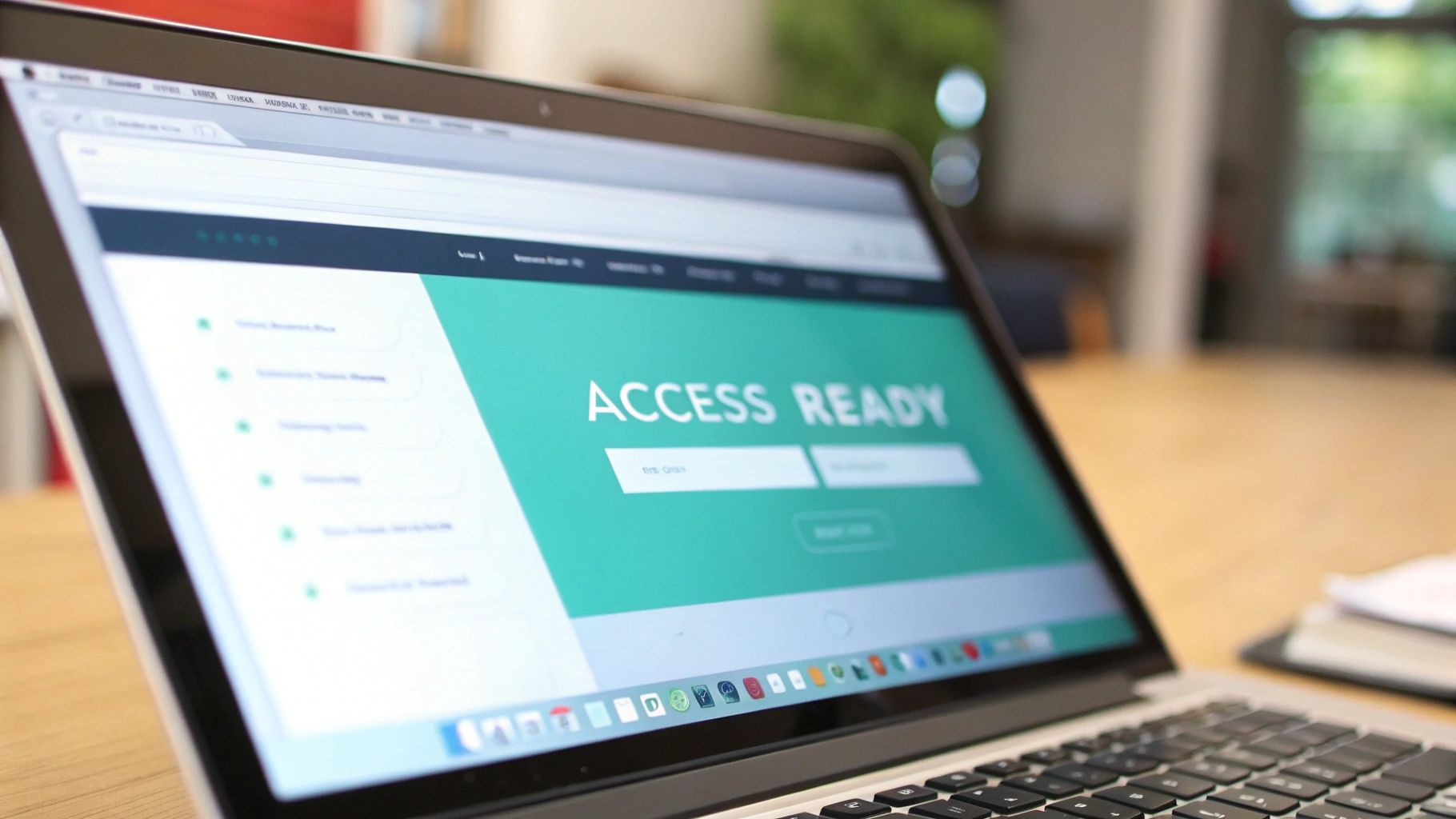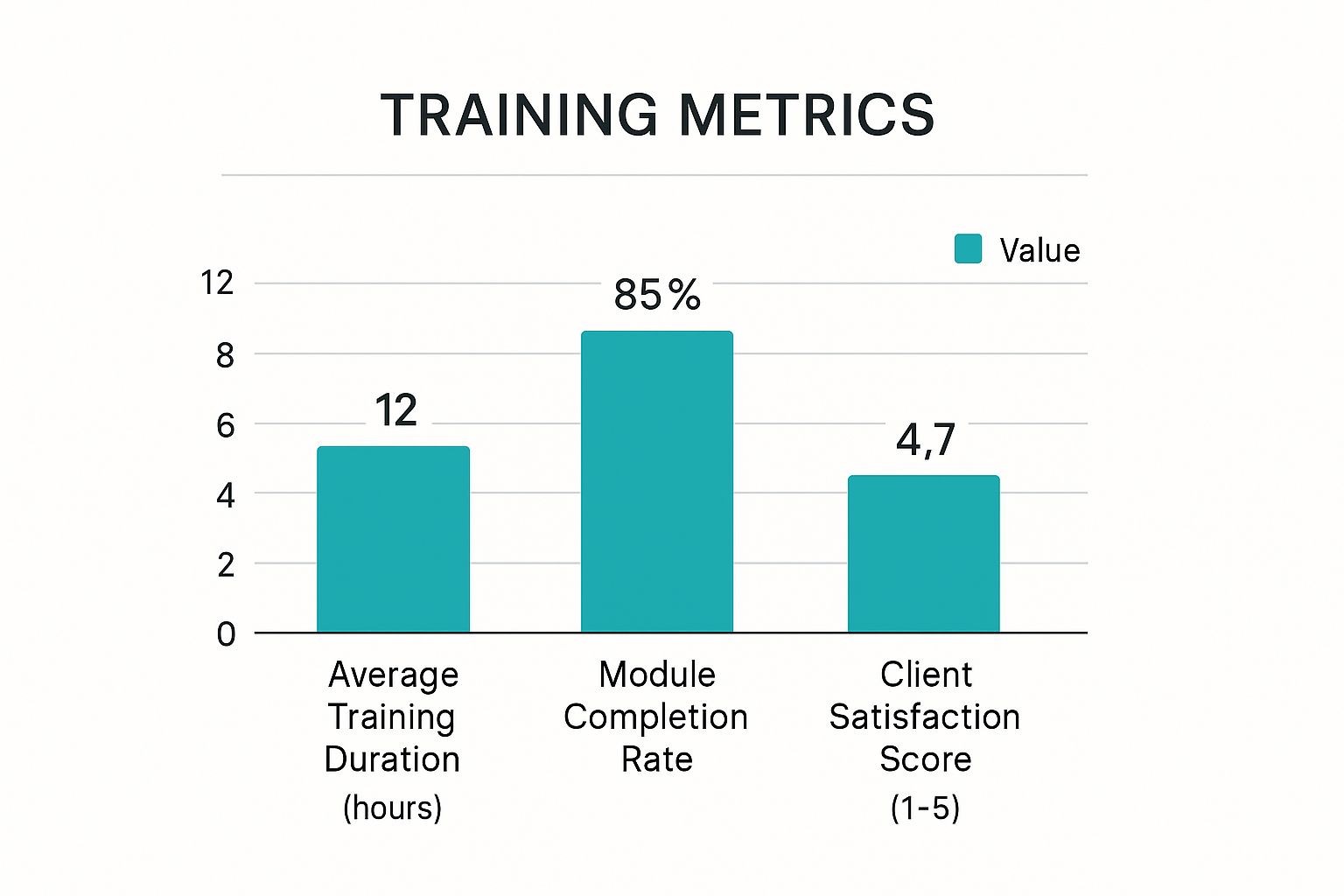New Client Onboarding Process
Streamline Your New Client Onboarding Process Today
Let's be honest. When you land a new client, it's easy to celebrate the win and just dive right into the work. But that time between them signing the contract and the project officially starting? That’s more than just a formality—it’s a moment of truth. Your new client onboarding process isn't just about sending a welcome email and sorting out paperwork; it's about setting the entire tone for your relationship.
Table of Contents
Streamline Your New Client Onboarding Process Today
Why Your New Client Onboarding Process Determines Everything
The True Cost of a Bad First Impression
Turning Onboarding into a Competitive Edge
Mapping Your Client's Journey Before They Know What's Coming
Identifying Critical Touchpoints
Building Systems That Work for Real Humans
Balancing Automation and Personal Touch
Mastering Communication During Those Critical First Weeks
Adapting Your Communication Style
Keeping Everyone on the Same Page
Measuring What Actually Matters in Your Onboarding Success
Key Metrics for Onboarding Training
From Initial Signals to Long-Term Value
Avoiding The Mistakes That Derail Even Good Intentions
The Perils of Poor Communication
Building Flexibility and Recovering Gracefully
Your Practical Roadmap to Onboarding Excellence
Phase 1: The Honest Audit and Quick Wins (Weeks 1-2)
Why Your New Client Onboarding Process Determines Everything

Let's be honest. When you land a new client, it's easy to celebrate the win and just dive right into the work. But that time between them signing the contract and the project officially starting? That’s more than just a formality—it’s a moment of truth. Your new client onboarding process isn't just about sending a welcome email and sorting out paperwork; it's about setting the entire tone for your relationship.
This is your first, and arguably best, chance to prove they made the right call. A clunky or confusing start immediately plants a seed of doubt. It gets them thinking, "If they're this scattered now, what's it going to be like when things get complicated?" On the flip side, a smooth, professional, and organized onboarding experience confirms their decision and builds instant trust. It shows you're on top of things, you care about their experience, and you have a clear system for getting results.
The True Cost of a Bad First Impression
Most businesses never really stop to think about the hidden costs of a bad onboarding experience. It’s not just about the risk of losing that one client. A frustrated client is far more likely to leave a negative review, which can scare away future customers. They’re also less likely to send referrals your way and more likely to question your invoices or push back on deadlines later on. You put so much effort into marketing and sales to get them in the door; failing here is like fumbling the ball on the one-yard line.
The numbers really drive this point home. That initial period is a massive factor in whether a client sticks with you long-term. In fact, 63% of customers say the onboarding phase is a critical part of their decision to commit to a service. Even more telling, a huge 87% of customers believe companies need to step up their game in this area, which tells you just how many businesses are getting it wrong. This isn't just a small detail; it's a huge opportunity to stand out.
Turning Onboarding into a Competitive Edge
When it’s done right, a top-notch new client onboarding process does more than just keep clients around—it turns them into advocates. When clients feel understood, supported, and confident right from the start, they become your most powerful marketing tool.
They are quicker to trust your guidance.
They are more forgiving if small problems pop up down the road.
They become genuine supporters of your brand.
By taking the time to map out these first interactions, which we’re about to dive into, you’re not just creating a checklist. You're building a system that fosters loyalty and turns brand-new clients into long-term partners who believe in what you do.
Mapping Your Client's Journey Before They Know What's Coming

The best onboarding experiences feel effortless to a client, almost like you’re reading their mind. But that magic doesn't just happen. It’s the result of someone taking the time to carefully chart out every single interaction. A truly solid new client onboarding process starts way before you send that first welcome email. It begins with you mapping their entire journey, from that first hesitant inquiry all the way to their first big win with your service.
This isn’t just a checklist of tasks. It's about stepping into your client's shoes. Think of yourself as a tour guide for someone visiting a new country. You wouldn't just give them a map and say, "Good luck!" You’d anticipate their questions: "Where’s the best local food? How does the subway work? Is there a local custom I should know about?" Your job is to answer your client's questions before they even have a chance to feel confused. This proactive approach turns potential anxiety into genuine confidence.
Identifying Critical Touchpoints
Every business has a slightly different client journey, but the core idea is the same: pinpoint every interaction and understand what the client is thinking, feeling, and needing at that moment. For example, a landscaping company's map might focus on the initial property visit, how the proposal is delivered, and the crew's first day on the job. A consulting firm's map, on the other hand, would zero in on the discovery call, the strategy session, and the first progress report.
To help you visualize this, here’s a quick comparison of what these critical touchpoints might look like across different business types.

Notice how each journey is tailored to the service being delivered. The key is to see the process from the client’s perspective, not just your own internal workflow.
By identifying these key moments, you can spot potential friction before it happens. Do clients often go silent after you send the contract? That’s a signal to schedule a brief call to walk them through it. Do they seem overwhelmed when you ask for initial information? That’s your cue to break it down into smaller, more digestible requests, maybe using a simple form builder like the one in Nurturely+.
Journey mapping isn't a "set it and forget it" task. It's a living document. After each client is successfully onboarded, ask them a couple of simple questions: "What was the easiest part of this for you?" and "Was there any point where you felt a bit stuck?" This feedback is gold. It’s what helps you turn a good process into a remarkable one that feels less like a procedure and more like a true partnership.
Building Systems That Work for Real Humans
A perfect journey map is a great start, but let's be honest, it's just a drawing. The real test of a standout new client onboarding process is building a system that doesn't fall apart the moment it meets actual human beings—your team and your clients. The goal isn’t to create a workflow that looks impressive in a presentation; it’s to build something people will actually use, especially when things get chaotic.
This is where you have to get brutally honest about your team's habits and your clients' real-world behavior. You could design a beautiful, multi-step portal for submitting documents, but if your clients are mostly on-the-go contractors who prefer snapping a photo on their phone, your elegant system just becomes a roadblock. The best systems meet people where they already are.
Balancing Automation and Personal Touch
Automation is your best friend for keeping things consistent and saving time, but it can't replace a genuine human connection. The trick is to automate the repetitive, administrative stuff so your team has more time for personal interactions that actually matter. Think about it this way:
Automate the reminders, not the conversation. Use a tool like Nurturely+ to automatically send follow-ups for an unsigned contract or an incomplete intake form. This frees you up to make a personal check-in call to ask if they have any questions, which feels supportive, not pushy.
Use templates as a starting point, not the final word. Standardized email templates are great for making sure no key information gets missed, but you should encourage your team to add a personal sentence or two. A simple, "Hope you had a great weekend!" can make all the difference and stop your communication from feeling robotic.
This balance is what separates a sterile, cold process from a warm, welcoming experience.
Fostering Internal Adoption
The most brilliantly designed new client onboarding process is completely worthless if your own team doesn’t buy into it. Resistance usually comes from feeling like a new process is just more work. You need to frame it differently: a solid onboarding system is there to reduce their stress, cut down on repetitive questions, and ultimately make their job easier.
This is where your internal processes directly reflect your external success. It’s interesting—organizations with a structured onboarding process see their employees become 50% more productive. When your team is properly brought into a new client process and understands its value, they’re far more likely to use it effectively, which is a direct win for the client. You can learn more about how strong onboarding drives performance by reading the full SHRM report findings.
Your system should be a support structure, not a cage. If you build it with enough flexibility to handle the messy reality of day-to-day business, it will serve both your team and your clients beautifully.
Mastering Communication During Those Critical First Weeks
A solid new client onboarding process isn’t about just checking off boxes on a list. It’s really about having the right conversations at the right moments. Those initial weeks are a make-or-break time, and how you communicate lays the groundwork for the entire relationship. Your goal should be to move beyond just sending updates and start building real confidence and managing expectations before they turn into problems.
This doesn't mean you should flood their inbox. It’s about being intentional. For example, instead of firing off a generic kickoff email, try sending a personal video message. It adds a human element right away and shows you're personally invested. The real skill is to reassure them without overwhelming them, giving just enough info to keep them feeling secure and in the loop.
Adapting Your Communication Style
Let's be real: every client is unique. A tech-savvy startup founder might prefer quick, informal updates in a shared Slack channel. On the other hand, the owner of a local service business might feel much more comfortable with a structured weekly summary email or even a quick phone call. If you don't adapt, you’ll create friction from the get-go.
The best way to handle this? Just ask. During your kickoff meeting, a simple question like, "What’s the best way for us to keep you in the loop?" shows you respect their time and workflow. This small step can make a huge difference.
You also need to be ready for those slightly awkward but necessary conversations. For instance, if a client is dragging their feet on providing information you need, a polite but firm automated reminder from a system like Nurturely+ can handle the initial nudge. This frees you up to make your follow-up more personal and focused on finding a solution together, rather than just chasing them down.
Keeping Everyone on the Same Page
Don't forget that internal communication is just as important as client-facing communication. When your sales team hands a new client over to the project or delivery team, crucial details can easily fall through the cracks. This forces the client to repeat themselves, which is always frustrating and makes you look disorganized.
To avoid this, use a central place, like a CRM, where all client notes, conversations, and key details are logged. This makes for a smooth transition and ensures everyone on your team is working with the same information, creating a cohesive experience for the client.
Good communication during onboarding also means proactively managing a client's natural anxiety. Starting something new can be stressful, so it’s your job to frame your process as a steady, reliable guide. You could say something like, "We know this is a lot to take in at once, so here’s a simple timeline of what you can expect over the next two weeks." Taking these small, thoughtful steps helps build a foundation of trust. And for businesses ready to scale, it's worth exploring how to automate customer support to handle common questions, freeing up your team for more high-touch interactions.
Measuring What Actually Matters in Your Onboarding Success
You can't improve what you don't measure. In the rush to track everything, it's easy to get caught up in vanity metrics—the kind that look impressive in a report but don't tell you if your new client onboarding process is actually effective. Truly successful businesses know how to find the signal in the noise, focusing on the key indicators that predict long-term client success.
This isn't about creating more work for your team by tracking dozens of data points. It's about being selective. Are new clients engaging with your welcome materials? How quickly do they experience that first "aha!" moment with your product or service? These are the questions that truly matter, far more than just counting how many welcome emails you've sent.
Key Metrics for Onboarding Training
For many businesses, especially those in the service industry, the initial training and setup phase is make-or-break. Measuring how this part of the journey goes can uncover hidden problems in your process. This infographic highlights a few essential training metrics you can start tracking right away.

From this data, you can see a potential story. Even with a high completion rate, a lengthy training process might be dragging down the overall client satisfaction score. It's a classic example of where quantitative data points to a qualitative problem.
From Initial Signals to Long-Term Value
A well-oiled onboarding machine has a direct impact on your bottom line. The efficiency of your process affects not just how happy your clients are, but also your operational costs and future revenue. For example, some studies show that simply using standardized onboarding templates can boost effectiveness by 20%, slash installation time by 49%, and even cut down client meeting time by a staggering 86%. You can explore more data on how efficient onboarding drives results to see just how much of an impact these small adjustments can make.
Tracking these numbers gives you a clear picture of what's working and what's not. To get a handle on these metrics, it's helpful to know what to aim for.
| Key Onboarding Metrics and Benchmarks | | :--- | :--- | :--- | :--- | | Metric | Industry Average | Top Performers | Measurement Method | | Time to First Value (TTFV) | 7-14 days | < 5 days | Track time from kickoff to first major milestone completion. | | Client Satisfaction (CSAT) Score | 75% | > 90% | Automated surveys after key onboarding phases. | | Onboarding Completion Rate | 80% | > 95% | System tracking of completed setup tasks or training modules. | | Support Tickets in First 30 Days | 3-5 per client | < 2 per client | Help desk software analytics. | | Product/Service Adoption Rate | 65% | > 85% | In-app usage tracking or feature adoption reports. |
This table shows that top-performing companies aren't just faster; they're also creating a better experience that leads to fewer support issues and higher satisfaction. The key takeaway is the strong link between a swift, efficient onboarding and a happy, engaged client.
To gather this kind of data, you don’t need an expensive, complicated setup. Simple feedback surveys sent automatically after key milestones can provide incredible insights. You can use the survey builder in Nurturely+ to create short, targeted questionnaires. I recommend asking specific, open-ended questions like:
On a scale of 1-10, how clear were our instructions during the kickoff call?
What was the single most helpful resource we provided you this week?
Was there any point where you felt stuck or unsure what to do next?
By tracking both hard numbers (quantitative scores) and direct feedback (qualitative comments), you can continuously fine-tune your process. This approach helps you build stronger client relationships and turns your onboarding into a powerful engine for growth. For more ideas on improving client communication, check out our guide on automated appointment reminders.
Avoiding The Mistakes That Derail Even Good Intentions

Even with a flawless plan on paper, a new client onboarding process can fly off the rails. The space between a good idea and a great client experience is where so many businesses stumble, often turning an excited new customer into a frustrated one. The first step to building a solid system that protects your client relationships is learning to spot these common traps.
One of the biggest mistakes I see is over-complicating things from the start. I once worked with a general contractor who had this beautiful, 12-page welcome packet. It was a masterpiece of design, but his clients—who were busy homeowners—felt completely swamped. All they really wanted to know was the project start date and when they needed to pick out paint colors. The takeaway? Your onboarding needs to feel simple for the client, even if it’s complex on your end. Boil it down to only what they need at that exact moment.
The Perils of Poor Communication
Another classic error is under-communicating, especially right after a client has committed. During onboarding, silence is almost never golden. When a client is left in the dark, their mind starts filling in the blanks, and the stories they invent are rarely positive. They start to wonder, "Did they forget about me?" or "Has something already gone wrong?" This is where having a proactive communication plan is absolutely crucial.
For instance, a marketing agency I know used to go dark for a full week after the kickoff call while their team did internal research. They learned the hard way that this radio silence created a mountain of anxiety for their new clients. Now, they send a simple automated email halfway through that week. It’s just a quick note that says, "Our team is hard at work on your strategy, and we're excited to share our initial findings with you next Tuesday." It's a small touch, but it makes a world of difference.
Building Flexibility and Recovering Gracefully
The last major pitfall is rigidity. No onboarding process is ever going to be perfect because no two clients are the same. Your system has to have some wiggle room to handle the messiness of the real world.
Here are a few ways I’ve learned to build in that flexibility:
Anticipate Common Detours: If clients keep asking the same question that isn't covered in your welcome guide, just add it. It's better to adapt to their behavior than to fight it.
Empower Your Team: Give your team members the authority to make small, on-the-fly adjustments without needing to run every little thing up the chain for approval.
Have a Recovery Plan: Look, mistakes are going to happen. When they do, the absolute worst thing you can do is pretend they didn't. Own it right away, give a sincere apology, and be crystal clear about what you're doing to fix it. A transparent recovery can actually build more trust than a perfect process ever could. When you handle problems with honesty, you show clients you’re a partner they can count on, even when things aren't perfect.
Your Practical Roadmap to Onboarding Excellence
Bringing all these ideas together can feel like a lot, but building a great new client onboarding process shouldn’t be a massive, overwhelming project. The secret is to break it down into manageable chunks. You want to make steady, meaningful progress rather than chasing perfection overnight. This is your action plan for getting there without burning out your team.
Phase 1: The Honest Audit and Quick Wins (Weeks 1-2)
Before you can build something better, you have to be brutally honest about where you are right now. The first step is to audit your current process—or the lack of one. Get your team together and literally map out every single thing that happens from the moment a client signs the contract. Don't gloss over the messy parts; this is where the gold is.
While you're auditing, your main goal is to spot the quick wins. These are small, easy changes that give you an immediate positive boost.
Create a Simple Welcome Email Template: This ensures every single client gets the same critical info right away. No more forgotten details.
Set Up a Shared Drive: Have a dedicated, organized folder ready for each new client before the kickoff call even happens. It shows you’re prepared.
Draft a Kickoff Call Agenda: Standardize your first meeting. This guarantees you cover key expectations and next steps every single time, setting a professional tone from the start.
Making these small adjustments creates momentum. It gets the team on board and excited because they can see the improvements right away.
Phase 2: Systemize and Solidify (Weeks 3-6)
With a few quick wins boosting morale, it's time to build a more solid framework. This is where you document everything, creating a central playbook so everyone on your team is on the same page. I'm talking about a detailed internal checklist that lays out every task, who's responsible for it, and its due date. If you need some help structuring this, our article on creating a five-step onboarding process is a great resource to model your plan after.
This phase is also the perfect time to bring in tools that do the heavy lifting for you. You can use a system like Nurturely+ to set up automated reminders for information requests or schedule those important check-in emails. This frees up your team to do what they do best: building a real relationship with the client. The goal here is to make your process consistent and reliable.
Phase 3: Refine and Elevate (Ongoing)
Think of your onboarding process as a living, breathing part of your business. Once the core system is running smoothly, you need to build a culture of continuous improvement. I suggest scheduling a quick review every quarter to talk about what’s working and what’s creating friction. More importantly, make it incredibly easy to get feedback from your clients. A simple, two-question survey sent after the first 30 days can give you priceless insights to make your process even better.
Ready to build an onboarding system that wins you clients for life? Discover how Nurturely+ can automate your workflows, streamline communication, and create an unforgettable client experience. Get started with Nurturely+ today!



